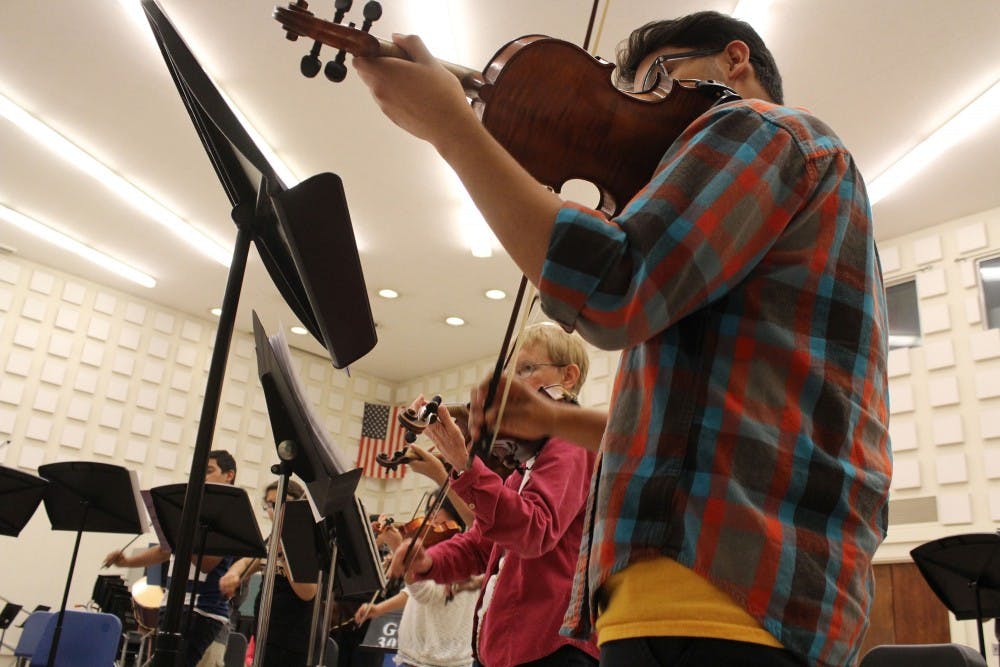As soon as you step into the room, it feels right. Soulful voices fill the air as the current of trumpets, violins and traditional instruments like the vihuela and guitarrón course through you. Some might not understand what they're saying, but the music played by the ASU Mariachi Ensemble defies the laws of language.
Mariachi music is a musical expression with ties all the way back to 19th century Mexico. It has a wide diversity of subgenres, with each varying in instruments, singing style, performance method, dance technique and more. Each variation is special and unique in its own way.
Mariachi music was added in 2011 to the list of Intangible Cultural Heritage of Humanity by the United Nations Educational, Scientific and Cultural Organization (UNESCO).
ASU's Mariachi Ensemble has a rich history at the University and was founded in 1984 by Dr. J. Richard Haefer.
In an email, Haefer said this was the first non-Western art ensemble to be established in the ASU School of Music curriculum, and "complemented the MA program in Ethnomusicology." The previous program was a combination of an all-student based ensemble (which offered one credit), and an ensemble comprised of students and community members, alike.
However, after 25 years, this program was dissolved in 2010. This cancellation was allegedly due to the ensemble's lack of members who were specifically music majors, and it was then altered to its current state as a class offered through the School of Music.
Despite these ups and downs, the School of Music's assistant director and one of the violinists in the current ensemble, Margaret Schmidt, maintains that the group is as strong and dedicated as ever.
"Music education at ASU encourages students to participate in ethnically or culturally related music," Schmidt said. "It’s good to get inside other music."
She said it's a valuable experience for students because it allows them to develop techniques they won't get elsewhere, like the firm, aggressive bow styling for violinists.
The Herberger Institute offers community classes, which allow non full-time ASU students to participate in the certain musical ensembles and groups. This allows high school students like Nataly Olaod to participate in what they love.
"I like how it brings people together," she said. "It’s just fun. You can feel the energy."
For ASU students like music education sophomore and trumpeter Anarbol Martinez, the ensemble allows them to connect with their heritage.
"This is like soul music," he said. "You get in touch with your inner Hispanic or Latino self."
Martinez said this is his first year playing mariachi, despite having played the trumpet for ten years.
"When I saw it offered at ASU, I was excited because I always wanted to play," he said. "When you’re into the music, you feel like you’re in another world."
One of the ensemble's directors and a Ph.D. student of the School of Music, Valerie Dopp, said that the ensemble allows students and members of the community to learn from each other.
"Community members have a lot of personal experience in mariachi, and ASU students usually have a stricter classical music background," she said. "It encourages (students) to let their hair down."
Dopp also said that mariachi is special because it incorporates so many other elements, from German polka to Jalisco ranchera.
"It’s not exclusive like, 'This is mariachi music,'" she said. "It's very inclusive."
The ensemble's spring concert will be Monday, April 25 from 7:30 to 10 p.m. The concert will feature well-known mariachi songs like "El Cascabel" and "La Negra" by Mariachi Vargas.
Related links:
Taco Shack opens on University, bringing 'Arizona-style' Mexican food to Tempe
ASU language immersion program helps Hispanic students learn English
Reach the reporter at nlilley@asu.edu or follow her @noelledl on Twitter.
Like The State Press on Facebook and follow @statepress on Twitter.




